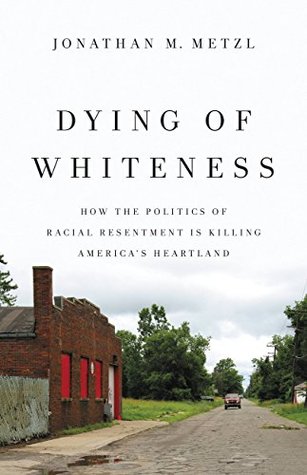More on this book
Community
Kindle Notes & Highlights
Read between
March 6 - March 8, 2020
Even on death’s doorstep, Trevor wasn’t angry. In fact, he staunchly supported the stance promoted by his elected officials. “Ain’t no way I would ever support Obamacare or sign up for it,” he told me. “I would rather die.” When I asked him why he felt this way even as he faced severe illness, he explained, “We don’t need any more government in our lives. And in any case, no way I want my tax dollars paying for Mexicans or welfare queens.”
Trevor voiced a literal willingness to die for his place in this hierarchy, rather than participate in a system that might put him on the same plane as immigrants or racial minorities.
Politics that, all too often, gained traction by playing to anxieties about white victimhood in relation to imagined threats posed by “Mexicans and welfare queens.”
this form of death was slow, excruciating, and invisible.
where on-the-ground white Americans make tradeoffs that negatively affect their lives and livelihoods in support of larger prejudices or ideals. By design, vulnerable immigrant and minority populations suffered the consequences in the most dire and urgent ways. Yet the tradeoffs made by people like Trevor frequently and materially benefitted persons and corporations far higher up the socioeconomic food chain—whose agendas and capital gains depended on the invisible sacrifices of lower income whites.
The white body that refuses treatment rather than supporting a system that might benefit everyone then becomes a metaphor for, and parable of, the threatened decline of the larger nation.
Second, these increasingly unified forms of conservatism advanced politically through overt or implicit appeals to what has been called white racial resentment.
This was both a top-down process (politicians used racial resentment as a tool for class exploitation) and a bottom-up one (the language of white resentment became an increasingly accepted way of talking about whiteness more broadly).7
positions that appeared to reflect racism instead reflected a larger, color-blind “hatred of the poor.”
emotionally and historically charged notions that white Americans should remain atop other racial or ethnic groups in the US social hierarchy, or that white “status” was at risk.
White backlash politics gave certain white populations the sensation of winning, particularly by upending the gains of minorities and liberals; yet the victories came at a steep cost. When white backlash policies became laws, as in cutting away health care programs and infrastructure spending, blocking expansion of health care delivery systems, defunding opiate-addiction centers, spewing toxins into the air, or enabling guns in public spaces, the result was—and I say this with the support of statistics detailed in the chapters that follow—increasing rates of death.
many lower- and middle-income white Americans continued to support these policies and ideologies—with their inherent links to narratives of imagined victimhood and domination—even after their negative effects became apparent and promises made by politicians such as Trump unraveled.
This is because white America’s investment in maintaining an imagined place atop a racial hierarchy—that is, an investment in a sense of whiteness—ironically harms the aggregate well-being of US whites as a demographic group, thereby making whiteness itself a negative health indicator.
Scholars and writers have long argued that the Republican Party rose to influence in the US South by taking advantage of white backlash against integration and civil rights to cajole white working-class people to vote against their own financial self-interests.
politics that claimed on face value to bolster white America ended up making even white lives sicker, harder, and shorter.
black men who attempted to demonstrate their own open-carry rights were attacked and jailed rather than lauded as freedom-loving patriots.
there has long been a congressional ban on funding for research on the health impact of firearms.
attempts to promote expanded health care rarely address the racial anxieties surrounding government health care
Tennessee’s refusal to expand Medicaid cost every single white resident of the state 14.1 days of life.
Popular resistance began to form only when cuts began to affect suburban white schools, but then it was often too late.
gun and health insurance policies affect health and mortality rates far more directly than do taxation and education spending policies.
racially driven policies in Missouri, Tennessee, and Kansas functioned as mortal risk factors for all people who live in these states.
Anti-blackness, in a biological sense, then produces its own anti-whiteness. An illness of the mind, weaponized onto the body of the nation.
white Americans increasingly represent a “paradox” of privilege, access, and social rewards on one hand and relatively poor health outcomes on the other.
When politics demands that people resist available health care, amass arsenals, cut funding for schools that their own kids attend, or make other decisions that might feel emotionally correct but are biologically perilous, these politics are literally asking people to die for their whiteness.
Couching politics in racial mistrust also makes it harder for white America to see how we—and I include myself as a white American here—would benefit self and country far more by emphasizing economic, legislative, and everyday cooperation rather than by chasing the false promise of supremacy.
guns themselves, within the trajectory of the narratives in the room, remain, like whiteness, assumed, unexamined, invisible. They are a part of us that helps us identify each other when we are all dressed in camouflage, seeking to blend in.
Turning a firearm on oneself (or a loved one in some cases of armed domestic murder-suicide) can fall into a category that experts call “impulsive”—a spontaneous response to immediate stressors,
The best research respects the culture and the traditions it studies and should feel grateful to be let in.


